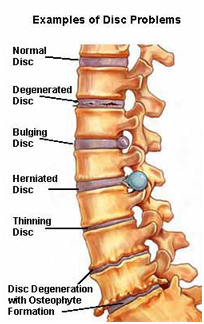The spine is made of bones (vertebrae) separated by soft cushions (discs). Pressure on the nerves that branch off of the spinal cord can produce pain, numbness, tingling, or weakness and may be caused by:
- Injured disks that bulge out (slipped disc) between the vertebrae
- Bone injuries (fractures)
- Narrowing of the space between vertebrae (spinal stenosis)
- Growths (tumours), pockets of infection (abscesses) or pockets of blood (haematomas)
 Patients with spinal pain in the neck or back are usually treated conservatively before surgery is considered. Bedrest, traction, anti-inflammatory medications (non-steroid and steroid), physical therapy, braces and exercise are often prescribed.
Patients with spinal pain in the neck or back are usually treated conservatively before surgery is considered. Bedrest, traction, anti-inflammatory medications (non-steroid and steroid), physical therapy, braces and exercise are often prescribed.
Maintaining good health, muscle strength and good posture with appropriate rest and exercise help prevent unnecessary strain on the spine and muscles.
How it’s done
The surgery is done while the patient is deep asleep and pain-free (general anaesthesia). For the neck (cervical spine) an incision may be made either in the back of the neck (posterior cervical) or in the front side of the neck (anterior cervical) depending on the location of the problem.
For the lower back (lumbar spine) an incision is made over the affected area. The bone that curves around and covers the spinal cord (lamina) is removed (laminectomy) and the tissue that is causing pressure on the nerve or spinal cord is removed.
The hole through which the nerve passes can be enlarged to prevent further pressure on the nerve. Sometimes, a piece of bone (bone graft) or metal rods (such as Harrington rods) may be used to strengthen the area of surgery.
Occasionally, screws (pedicle screws) are used to stabilize the rods to the bones.
Outcomes
The outcome depends on the source of the problem or the extent of the injury but most patients do very well after surgery. It should be remembered that this operation is done usually for problems in the legs, having little effect on long term back pain.
Convalescence
The hospital stay is about 4 days. The patient is encouraged to walk the first day after surgery to reduce the risk of blood clots (deep venous thrombosis). Complete recovery takes about 5 weeks. Heavy work is not recommended until several months after surgery.
